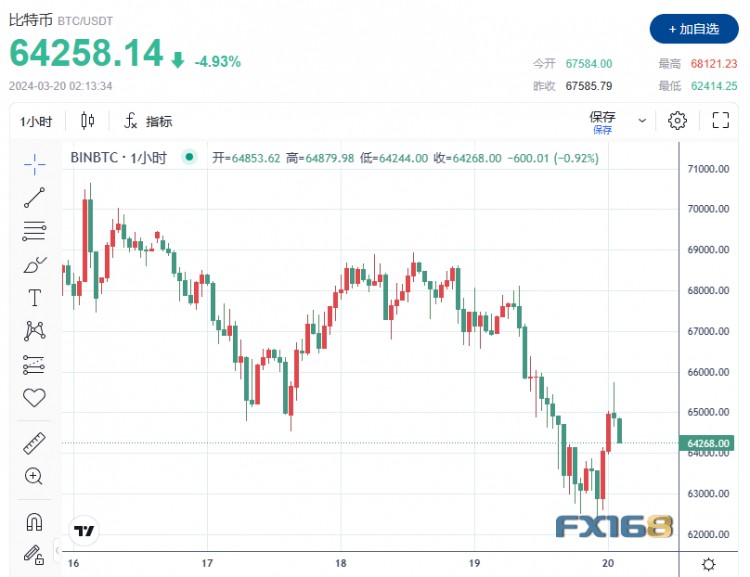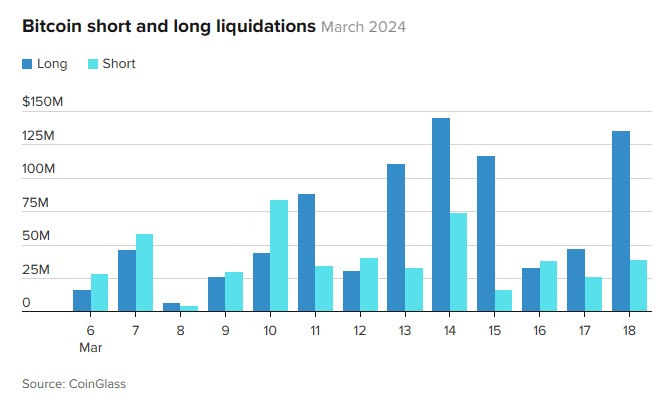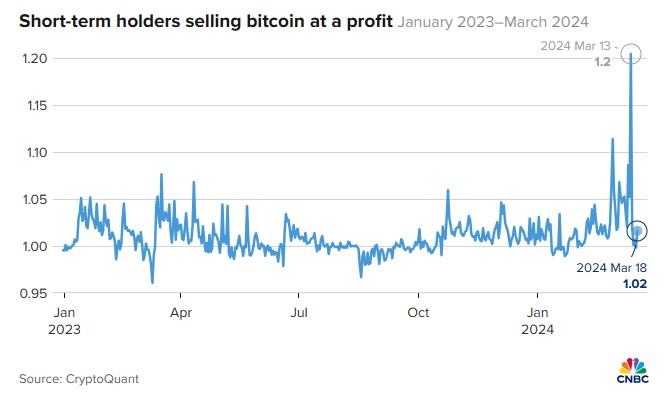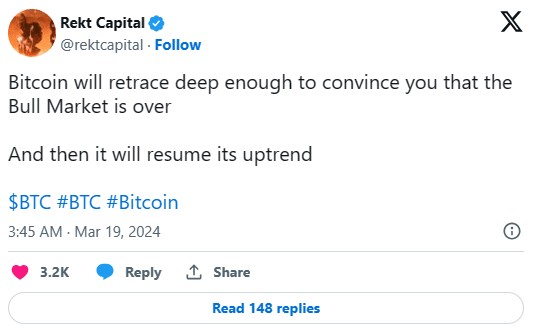Time:2024-03-20 Click:76
On Tuesday (March 19) in the U.S. market, Bitcoin continued its decline, falling by more than $10,000 from the all-time high hit last week.
Markets show that the flagship cryptocurrency fell more than 7% to $62,414.25, a $11,000 drop from the record high of $73,679 reached last week.

Coinglass data shows that in the past 24 hours, a total of 220,000 people liquidated their positions in the virtual currency market, with a total liquidation amount of US$641 million.

Lipiński Bartosz, CEO of Cube.Exchange, said: “As ETFs buy up the available supply of Bitcoin on the open market and continue to reduce liquidity, this situation may become more frequent and may lead to concerns about Bitcoin. Losing confidence in the integrity of pricing and starting to look to other crypto assets.”
The move also dragged other cryptocurrencies lower. The price of Ethereum fell more than 9%, falling below $3,200, hitting a new low since February 28. Ethereum topped $4,000 last week for the first time since December 2021. Some analysts are predicting a drop in the price of Ethereum following the network’s Denver upgrade. Solana-related tokens fell 7%, Dogecoin fell 5% and Ripple fell 2%.
Crypto-related stocks pared earlier losses but remained under pressure. Bitcoin agency MicroStrategy fell 6.5% and cryptocurrency exchange Coinbase fell 3%. Mining stocks fell across the board, with Riot Platforms and Marathon Digital, the two largest companies, falling 1% and 2% respectively.
"Overall, it makes sense that this pullback is short-lived and that the rebound will resume - although the specter of a recession looming over the market next year may temper the rebound in ways we cannot foresee," Lipiński said.

Bitcoin's weakness began last week, when traders began taking profits following its roughly 70% rise from the start of the year to last Wednesday. Data from CryptoQuant shows that on March 12, a large number of short-term Bitcoin holders sold Bitcoin to make a profit.
This profit-taking has led to a surge in leveraged Bitcoin long liquidations. According to data from CoinGlass, approximately $142 million in long positions have been liquidated on various centralized exchanges in the past 24 hours, with Monday’s liquidation amounting to $122 million. Last week, from Wednesday to Friday, there were approximately $372 million in long positions being liquidated.

Data provided by Coinglass shows that bulls are the biggest losers from this pullback, as Bitcoin’s continued climb over the past three weeks has many traders believing that Bitcoin will “only go up” in the foreseeable future, which is generally the case for crypto. When there is a major correction in the currency sector.

On Monday, inflows into spot Bitcoin ETFs turned negative for the first time since March 1, largely due to a $642.5 million outflow from Grayscale’s GBTC, the largest single-day outflow on record for the firm.

Data provided by Farside shows that GBTC currently has total outflows of more than $12.4 billion, while BlackRock IBIT has total inflows of $12.96 billion. In total, the ETF has a net flow of US$12 billion and currently holds 8.366 million Bitcoins, worth approximately US$53.1 billion.
Is the bull market peaking or a correction in the rising cycle?
The successful launch of a spot Bitcoin ETF in the United States earlier this year was a key factor in Bitcoin's rise. Bitcoin’s rally began even before the ETF was launched in anticipation of regulatory approval. At the same time, investor interest and higher demand for Bitcoin have also led to increased leverage and increased high-frequency volatility.
Investors and analysts have warned that traders should exercise caution in March as heightened price volatility, coupled with increased trading volume, will lead to a pullback in Bitcoin's long-term upward trend.
While many crypto naysayers now believe this bull run has peaked, the fact that the halving is more than 30 days away suggests otherwise, as a typical cycle usually takes six to nine months to reach after a halving. peak.
The inflows into ETFs so far are impressive, but this may be just the beginning as most investment advisors still haven’t started recommending their clients allocate to Bitcoin.
Grant Engelbart, vice president and investment strategist at Carson Group, said that only a “handful” of advisors have allocations to Bitcoin ETFs, with the average allocation rate being 3.5%. Carson Group is one of the first advisory platforms to join ETF.
Many analysts are now pointing to the halving as the next catalyst for Bitcoin and the broader crypto market, and believe prices will trade sideways until then.
“Bitcoin is now a significant institutional asset like never before,” Henry Robinson, co-founder and head of crypto at Decimal Digital Currency, said in a report shared with Kitco Crypto. “New Bitcoin ETFs have net inflows of 9-10 figures per week, holding over 400,000 Bitcoins, over 800,000 if GBTC is included, and over 1 million if micro strategies are also included. "
“We are seeing this accumulation already starting to impact the price, and the post-halving effect at current prices means that the monthly new supply of Bitcoin will soon be reduced by about $800 million,” he said. “We expect 2024 to Further record highs.”
When talking about the heavy losses of derivatives traders, Robinson emphasized, “When everyone thinks that profits are a sure thing and the market sentiment is very optimistic, leverage traders tend to be wiped out. We are very concerned about this kind of situation before the halving. A pullback is not surprising, and by unwinding more extreme bullish bets before continuing higher, we would definitely call this a 'buy the dip' opportunity."
"The Bitcoin market is getting smarter and richer. All this new liquidity from ETFs makes Bitcoin more rationally priced and thwarts market manipulation," he said. “More importantly, Bitcoin ETFs lay the foundation for teaching Bitcoin knowledge to traditional asset managers. They may have overlooked this before out of caution or regulatory restrictions, but now many are taking a closer look and will realize Incredible risk-reward ratio. Adoption is just beginning.”
“The market is clearly trying to accumulate Bitcoin in large quantities, but it will take time for price action to follow local supply and demand,” Robinson concluded. “As market participants begin and exit their halving bets, we may be looking ahead to and after the halving. This is followed by aggressive bullish action, dramatic selling, or both.”
For those who haven’t experienced the cryptocurrency bull run and the volatility that comes with it, market analyst Rekt Capital has the following suggestions for when the Bitcoin bull run is expected to resume.
